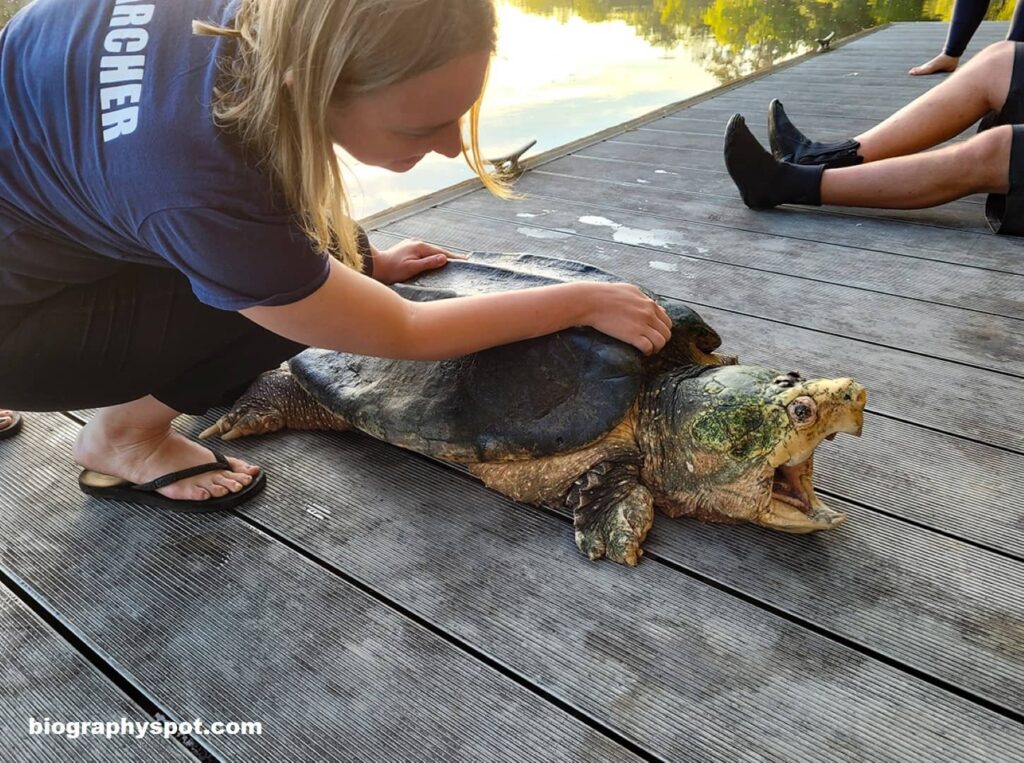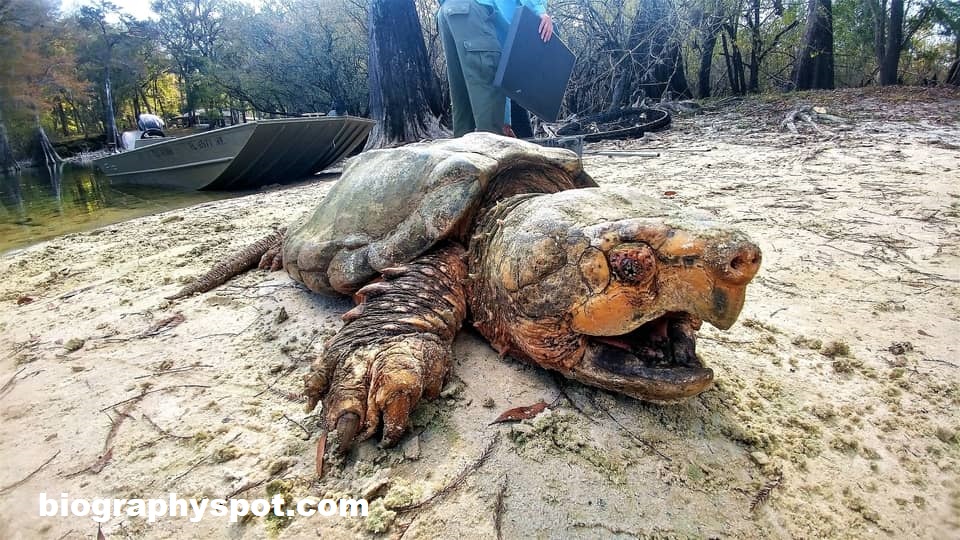Introduction to the Thanos Alligator Snapping Turtle
Overview of the Thanos Turtle Phenomenon
The Thanos alligator snapping turtle isn’t your average reptile. With its rugged, ancient look and super strong jaw, it has the kind of presence that makes people stop scrolling. It’s one of those creatures that looks like it walked straight out of a fantasy movie—and the internet fell in love with it for exactly that reason.
People were amazed by how prehistoric and powerful this turtle looked. It sparked conversations, memes, and even some jaw-dropping reactions online. Once someone saw it, they had to know more. And just like that, the Thanos turtle became a viral star.
Quick Facts: Thanos Alligator Snapping Turtle
- Scientific Name: Macrochelys temminckii
- Known For: Powerful jaw and Thanos-like appearance
- Habitat: Freshwater swamps and rivers in the southeastern U.S.
- Conservation Status: Vulnerable due to habitat loss and pet trade
How It Gained Internet Fame
It all started with a few photos shared on social media. You know the kind—the ones that make you go, “Is this even real?” Its rough, armored skin, sharp beak, and intense stare gave serious supervillain vibes. So, naturally, the internet took it and ran.
Soon, animal lovers, meme creators, and Marvel fans were all sharing the same pictures. Some people couldn’t believe it was real. Others wanted to know everything about it. Before long, the Thanos alligator snapping turtle had its own fan base.
Why It’s Named After “Thanos”
Let’s be real—this turtle kind of looks like it could battle the Avengers. Its bumpy, rugged shell and fierce look reminded people of Thanos, the big bad villain from the Marvel Universe. The nickname just fit perfectly, and once it caught on, there was no turning back.
The name isn’t official, of course. Scientists don’t call it the “Thanos turtle.” But thanks to its intimidating appearance and viral fame, the name stuck. Now, it’s known online as one of the coolest (and scariest-looking) turtles ever.
What Is the Thanos Alligator Snapping Turtle?
The Thanos alligator snapping turtle is a unique and rare species of turtle known for its striking appearance and powerful bite, often compared to the villain Thanos from Marvel.
Scientific Classification and Background
The Thanos alligator snapping turtle is a type of freshwater turtle. It belongs to the species Macrochelys temminckii. This turtle has been around for millions of years. Some people even call it a “living fossil.”
It lives mostly in rivers and swamps in the southern U.S. It’s one of the biggest freshwater turtles in the world. And it’s known for its strong bite and rough, dinosaur-like look.
Unique Features That Make It Look “Villainous”
What makes this turtle so special? Just one look at it says everything. Its dark, bumpy shell looks like thick armor. Its mouth is huge and shaped like a hooked beak. And those eyes? Cold and serious, like it’s been through a lot.
That scary look is what gave it the name “Thanos turtle.” It’s not mean—it just looks like it could rule a swamp like a boss. People love how tough and cool it looks, almost like it’s not from this world.
How It Differs from Regular Alligator Snapping Turtles
This turtle isn’t a new species—it’s still an alligator snapping turtle. But the ones that go viral usually have extra bold features. Bigger heads, darker shells, sharper jaws. That’s what sets the “Thanos” ones apart.
Most alligator snappers are wild-looking, but not all look this intense. The Thanos version is the one that stands out and takes over your feed. It’s like the superhero version of the species—tougher, scarier, and totally unforgettable.
Habitat and Natural Environment
The Thanos alligator snapping turtle thrives in the warm, freshwater environments of slow-moving rivers, swamps, and lakes in the southeastern United States.
Where the Thanos Turtle Is Found
The Thanos alligator snapping turtle lives in the southeastern United States. You’ll mostly find it in states like Texas, Louisiana, Georgia, and Florida. It loves slow-moving rivers, muddy swamps, and freshwater lakes.
These turtles like to stay hidden. They spend most of their time under water or buried in the mud. You might not even see one unless you’re really looking.
Ideal Conditions for Its Survival
This turtle needs clean, calm water to live well. It likes places with soft bottoms, lots of plants, and plenty of fish to eat. Shade from trees helps keep the water cool and comfy.
They don’t do well in dirty or fast-moving water. If their home gets polluted or dries up, they can’t survive. That’s why keeping wetlands healthy is so important.
Role in the Ecosystem
The Thanos turtle plays a big part in keeping rivers balanced. It eats fish, frogs, and even dead animals. That helps stop disease and keeps things clean.
It’s also food for bigger animals when it’s young. So even though it looks tough, it’s part of a big circle of life. Without it, the ecosystem just wouldn’t be the same.
Diet and Feeding Behavior
The Thanos alligator snapping turtle is a carnivore, feeding on fish, frogs, and small animals, using its powerful jaws and worm-like tongue to catch prey.
What the Thanos Turtle Eats in the Wild
The Thanos alligator snapping turtle is a meat-eater. In the wild, it eats fish, frogs, snakes, and even birds if it can catch them. It also munches on dead animals that sink to the bottom of the water.
This turtle isn’t picky. If it can fit it in its mouth, it’s probably food. That’s one reason it survives so well in the wild.
Hunting Techniques and Powerful Jaw Mechanics
This turtle is a sneaky hunter. It sits still for hours with its mouth wide open. Inside its mouth is a pink, worm-like tongue. It wiggles that tongue to trick fish into coming closer. Then—snap!—the turtle strikes in a flash.
Its jaw is crazy strong. It can crush bones and break through shells. That’s why people say its bite is one of the strongest in the turtle world.
Feeding Schedule in Captivity
In captivity, the Thanos turtle doesn’t hunt—but it still eats like a boss. Keepers feed it fish, shrimp, and raw meat. Sometimes they add vitamins to keep it healthy.
It usually eats every few days, not every day. Overfeeding can make it sick, so timing and portion size really matter.
Behavior and Temperament
The Thanos alligator snapping turtle is generally calm but can be aggressive when threatened, using its strong bite to defend itself from danger.
Is the Thanos Turtle Aggressive?
Despite its scary looks, the Thanos alligator snapping turtle isn’t mean. It’s more chill than you’d think. In the wild, it doesn’t chase animals or go looking for trouble. It just waits, strikes, then goes back to hiding.
But if it feels trapped or poked, it will snap. That bite isn’t a joke. So yeah, it’s peaceful unless you mess with it.
Interaction with Other Aquatic Species
This turtle mostly keeps to itself. It doesn’t play nice, but it doesn’t bother others unless it’s hungry. Fish, frogs, and small animals need to watch out—but turtles and big fish usually get left alone.
It’s a quiet boss in the water. Other animals know to give it space.
Response to Human Contact
The Thanos turtle isn’t friendly like a pet dog. It doesn’t like being held or touched. If you try to handle one, it might hiss or bite. Not out of hate—but out of fear or defense.
In the wild, it avoids people. In captivity, it can get used to humans, but it still wants to be left alone most of the time.
Conservation Status and Threats
The Thanos alligator snapping turtle is considered a threatened species due to habitat loss, pollution, and illegal hunting, making conservation efforts essential for its survival.
Is the Thanos Turtle Endangered?
Yes, the Thanos alligator snapping turtle is at risk. It’s not gone yet, but its numbers are going down. That’s why many states protect it. In some places, it’s even listed as a threatened species.
The biggest danger? People. Overhunting and habitat loss have made life tough for this ancient turtle.
Environmental Challenges
These turtles need clean, quiet rivers to live. But pollution, dams, and drained swamps are ruining their homes. Trash in the water makes them sick. And when forests are cut down, shade and shelter disappear.
They also get caught in fishing nets and traps. Even if it’s by accident, it still hurts the turtle population.
Conservation Efforts to Protect the Species
Good news—people are stepping up. Many wildlife groups are working to save these turtles. They protect nests, clean rivers, and release turtles raised in care back into the wild.
Laws now stop people from hunting or selling them. Some areas even have turtle rescue programs. It’s not perfect yet, but it’s a start toward saving this tough but gentle creature.

Captivity and Pet Trade Considerations
Owning a Thanos alligator snapping turtle is illegal in many places due to its protected status, and ethical concerns surround the pet trade and captivity of this species.
Is It Legal to Own a Thanos Alligator Snapping Turtle?
Owning a Thanos alligator snapping turtle isn’t as simple as buying a pet at the store. In many places, it’s illegal to keep one. These turtles are protected by law because they’re at risk of extinction.
Even in states where it’s allowed, you might need a special permit. So, before getting one, make sure to check the local laws. Protecting wild animals is super important!
Ethical Concerns Around Ownership
Even if it’s legal, keeping a Thanos turtle as a pet raises big ethical questions. These turtles are meant to live in the wild, not in a small tank. They need space, water, and a natural environment. Taking them from the wild can harm their population.
Plus, the pet trade can be dangerous for them. Many are caught illegally or transported poorly. So, it’s always better to support conservation efforts instead of buying one.
Best Practices for Captive Care
If you already have a Thanos turtle (and it’s legal), caring for it is a big responsibility. These turtles need a huge tank with clean, warm water. Make sure the water is deep enough for them to swim and dig. They also need hiding spots to feel safe.
A good diet is important, too. Feed them fish, shrimp, and other fresh meat to keep them healthy. And remember, they need regular check-ups with a vet who knows turtles.
Myths, Memes, and Pop Culture
The Thanos alligator snapping turtle became an internet sensation, with memes and comparisons to the Marvel villain Thanos, boosting its popularity and creating fun myths about its powers.
Social Media’s Role in Popularizing the Thanos Turtle
The Thanos alligator snapping turtle really hit the big time on social media. Memes, viral photos, and funny videos made it a household name. People couldn’t get enough of its intimidating look, and they loved comparing it to Thanos from Marvel.
As more and more people shared the turtle’s pics, the internet created a whole personality for it. This wasn’t just a turtle—it was a superstar with a fan base, memes, and even a backstory. Thanks to social media, the Thanos turtle went from a cool animal to a pop culture icon.
Comparisons to the Marvel Character
It didn’t take long for fans to start comparing the Thanos turtle to the infamous Marvel villain. The turtle’s sharp features, powerful jaw, and tough exterior reminded everyone of Thanos. The meme made perfect sense—this turtle could snap like the villain and maybe even take over the world (or at least a swamp).
Of course, the comparisons aren’t exactly accurate, but they were too fun not to share. Fans of both the turtle and the Marvel universe embraced the connection. It was the perfect blend of real-life nature and fictional heroism.
Real vs. Fiction: Debunking Online Claims
While it’s fun to imagine the Thanos turtle as a villain, it’s important to separate fact from fiction. Some online posts claimed that these turtles were deadly predators or had superhuman powers. Spoiler: They don’t.
The Thanos turtle is powerful, but it’s not a supervillain. It’s a fascinating, ancient species with a strong bite, but it’s not out there conquering anything. Debunking these myths is important so people don’t misunderstand or fear these amazing creatures.
Importance of Alligator Snapping Turtles in Biodiversity
Alligator snapping turtles, including the Thanos variety, play a crucial role in maintaining aquatic ecosystems by controlling prey populations and supporting overall biodiversity.
Their Role in Maintaining Aquatic Ecosystems
Alligator snapping turtles play a huge role in keeping aquatic ecosystems healthy. As top predators, they help control the populations of smaller animals, like fish and frogs. By eating these creatures, they maintain a balance in the food chain.
Without these turtles, certain species might overpopulate and disrupt the entire ecosystem. So, in their quiet, patient way, they help ensure everything in the water stays in harmony.
Educational and Ecological Significance
These turtles also serve as a great teaching tool. They show us how nature’s creatures are all connected. By studying them, scientists can better understand how ecosystems function. They also highlight the importance of protecting endangered species.
Beyond education, these turtles remind us that every species, no matter how small or tough, plays an important role in the big picture. Protecting them means protecting the balance of nature itself.Research is key to understanding the ecology of species like the Thanos alligator snapping turtle. You can explore more about aquatic ecosystem conservation and endangered species through the National Wildlife Federation, which provides valuable resources and studies on wildlife protection.
How Protecting One Species Affects the Whole Habitat
When we protect species like the alligator snapping turtle, we’re not just saving one animal. We’re saving entire ecosystems. By ensuring these turtles thrive, we help other animals and plants that depend on the same habitat.If you’re fascinated by unique and intriguing personalities, like the rare and fascinating Thanos alligator snapping turtle, you might also enjoy learning about the life of Isabella Russo, the actress in our previous post.
It’s a domino effect—protecting one species leads to healthier rivers, lakes, and swamps. And a healthier environment benefits everyone, including us!
Conclusion
In conclusion, the Thanos alligator snapping turtle is a unique and fascinating species that plays a vital role in maintaining the balance of aquatic ecosystems. While it has gained fame through pop culture, it’s important to protect and conserve this remarkable creature to ensure its survival. By understanding its habitat, behavior, and conservation needs, we can help safeguard the future of the Thanos turtle and the environment it thrives in.
FAQs
-
Is the Thanos Alligator Snapping Turtle real or fake?
Yes, it’s real! While the name “Thanos” is a nickname, the turtle itself is a legitimate species known for its ancient, armored look.
-
Why is it called the “Thanos” turtle?
Because of its tough, rugged appearance and strong jaw, people online began comparing it to the Marvel villain, Thanos.
-
How dangerous is the Thanos Alligator Snapping Turtle?
It’s not dangerous to humans unless provoked, but it has a strong bite and should be handled carefully.
-
Can you keep a Thanos turtle as a pet?
In some places, yes—but it requires special care, space, and legal permission.
-
What does the Thanos turtle eat?
Its diet includes fish, frogs, insects, and even small mammals. It’s a carnivore with powerful hunting instincts.
-
Where can the Thanos turtle be found in the wild?
Primarily in freshwater rivers, lakes, and swamps in the southeastern United States.
-
How long does the Thanos snapping turtle live?
They can live 50 to 100 years, making them one of the longest-living freshwater turtles.
-
Is it endangered or protected?
Some populations are considered vulnerable due to habitat loss and poaching. Conservation laws vary by region.
-
What’s the difference between a common and alligator snapping turtle?
Alligator snappers, like the Thanos turtle, are larger, more aggressive, and have stronger jaws than common snappers.
-
Can the Thanos turtle bite through bone?
Its bite force is incredibly strong—while not quite bone-crushing, it can do serious damage to flesh and softer materials.



